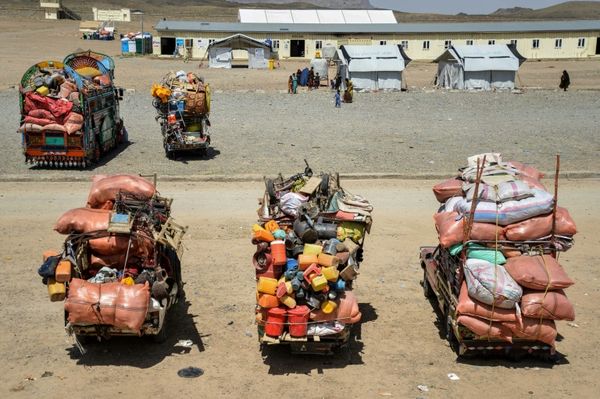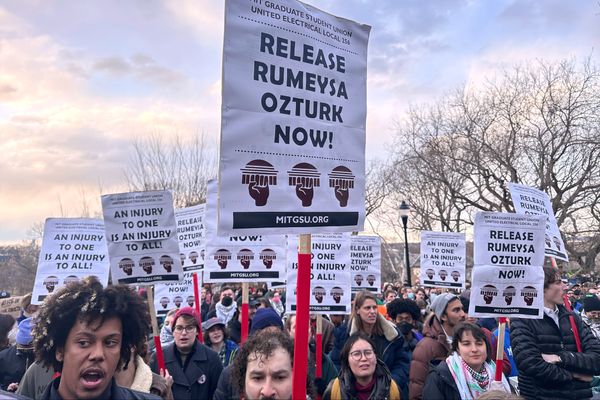
For more than four decades, the Lazraq family in Morocco has been amassing an extraordinary collection of modern and contemporary African art. One of the most comprehensive private holdings on the continent, it has mostly remained unseen, tucked away in vaults. But from next month, the collection will have a new permanent presence at the Museum of African Contemporary Art Al Maaden (Macaal) in Marrakech.
The revamped museum, founded by Othman Lazraq, the son of the real estate tycoon Alami Lazraq, has shifted towards a semi-permanent exhibition format, hosting 150 works on rotation from the 2,500-strong collection.
Meriem Berrada, the museum’s artistic director, hopes the new exhibition, Seven Contours, One Collection, will help challenge what she calls “reductive stereotypes” with its breadth and inclusivity, featuring works from the majority of Africa’s 54 countries.
It spans multiple mediums from photography, painting and sculpture, to textiles, video art and installations. Notable pieces include works by Moroccan pioneers such as Farid Belkahia, Mohamed Melehi, and the Congolese artist Pierre Bodo, Sudanese painter Salah Elmur, and Malawian artist Billie Zangewa.
Works by Malian photographer Malick Sidibé and South African artist Chris Soal, known for his use of unconventional found objects, are also featured, as are early figurative pieces by Moroccan artist Saâd Hassani. The most expensive in the collection are the works of Moroccan painter Ahmed Cherkaoui.
While retaining its riad-style architecture, Macaal’s O-shaped building, which first opened in 2016, has undergone extensive renovations and will house eight exhibition spaces across two floors when it reopens on 2 February.
Seven galleries are dedicated to the permanent collection, and an eighth will host solo shows, beginning with the French-Moroccan artist Sara Ouhaddou.
“African art is not a fleeting trend, as some galleries in the western world might suggest,” says Othman Lazraq, the president of the museum. “While there has been a surge in showcasing African contemporary art, particularly portraiture, over the past few years this represents only a fraction of what African art has to offer … It spans a rich diversity of mediums, practices and traditions that go far beyond figurative portraiture.”
Lazraq has helped to expand his father’s collection by adding contemporary works so that about 300 artists are represented. One of his first purchases was two photographs by Leila Alaoui, who died in a terrorist attack in Ouagadougou, the capital of Burkina Faso, at the age of 33.
While Morocco is home to the state-run Mohamed VI Museum of Modern and Contemporary Art in Rabat, Macaal is the first private collection of this scale to open to the public. Elsewhere in Africa, privately run art institutions are on the rise, including Fondation H in Madagascar, the Kamel Lazaar Foundation and 32Bis in Tunisia, Fondation Zinsou in Benin and the Zeitz Mocaa in South Africa.
Berrada, who was included in Apollo art magazine’s 2020 list of “40 Under 40” influential African art figures, says Seven Contours, One Collection aims to challenge western categorisations of art and craft. “Our approach must remain organic because replicating a western canon in our country simply won’t work,” she says.
Berrada is irked when people refer to African art in the singular. “It’s African arts. It’s plural, because it’s very diverse,” she says. “We tend to use Africa as a frozen block, but it’s not like that at all. We shouldn’t fall into simplifications.”
The first of the seven rooms is labelled Decolonise, and shows Farid Belkahia’s goat-skin paintings alongside works by Tunisian artist Nidhal Chamekh, who imagines alternative histories through reinterpretation and deconstruction of colonial iconography.
Another room, Transcribe, explores the power of written signs and visual alphabets, showcasing M’Barek Bouhchichi’s engraved wood sticks inspired by nomadic Saharan communities alongside Frédéric Bruly Bouabré’s unique writing system blending Bété, French, and imaginary pictograms.
One of two works by Amina Agueznay features in a room celebrating the continent’s textile and craft traditions, alongside pieces by Ghanaian artist Serge Attukwei Clottey. Agueznay’s Talisman of Henna blends tradition with contemporary art by combining crochet and sewing techniques to create a handcrafted piece using natural spun henna-dyed wool, cotton thread, balsa wood and stainless steel.
Macaal’s main atrium features a new site-specific work by eco-architect and anthropologist Salima Naji, crafted from local materials including adobe and rammed earth. Aïcha Snoussi’s drawings in the central stairwell extend across the surrounding walls, addressing identity, queer perspectives and power dynamics.
As part of its mission to make art accessible, Macaal has organised cultural bootcamps for African museum professionals run by the likes of Koyo Kouoh, the first African woman appointed to curate the Venice Biennale.
It is also reaching out to the local community. “For me, when a child visits with their school and then brings their parents back later, I feel we’ve achieved something truly important,” Berrada says. “When we invite all the taxi drivers of Marrakech to share couscous in our garden with the curator, and then the taxi driver brings their family too – that’s when I believe we’ve succeeded.”
Echoing Berrada, Lazraq speaks about “democratising access” to African contemporary art. “Don’t forget, 98% of the people in Morocco never put a foot in a museum,” he says.
“When we opened Macaal, we had almost no visitors; we were essentially begging people to come. We had to be creative and come up with initiatives to attract them – inviting people for lunch, organising outdoor cinemas, hosting concerts and more.
“In Morocco, the mentality isn’t about waiting for people to come to you – it’s about going out and bringing them in. Our goal is to inspire, especially the youth, and show them that they too can be artists if they choose to.”







